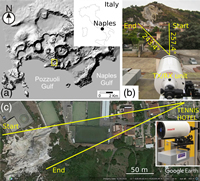Increasing CO2 flux at Pisciarelli, Campi Flegrei, Italy
Manuel Queißer, Domenico Granieri, Mike Burton, Fabio Arzilli, Rosario Avino, and Antonio Carandente (2017).
Solid Earth, 8, 1017-1024, https://doi.org/10.5194/se-8-1017-2017.
Introduction
The Campi Flegrei caldera is located in the metropolitan area of Naples (Italy) and has been undergoing different stages of unrest since 1950, evidenced by episodes of significant ground uplift followed by minor subsidence, increasing and fluctuating emission strengths of water vapor and CO2 from fumaroles, and periodic seismic crises. We deployed a scanning laser remote-sensing spectrometer (LARSS) that measured path-integrated CO2 concentrations in the Pisciarelli area in May 2017. The resulting mean CO2 flux is 578 ± 246 t d−1. Our data suggest a significant increase in CO2 flux at this site since 2015. Together with recent geophysical observations, this suggests a greater contribution of the magmatic source to the degassing and/or an increase in permeability at shallow levels. Thanks to the integrated path soundings, LARSS may help to give representative measurements from large regions containing different CO2 sources, including fumaroles, low-temperature vents, and degassing soils, helping to constrain the contribution of deep gases and their migration mechanisms towards the surface.


